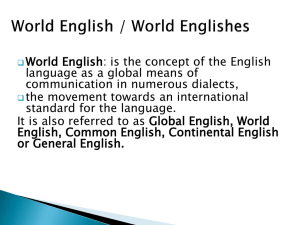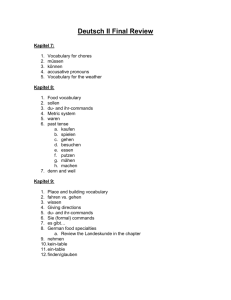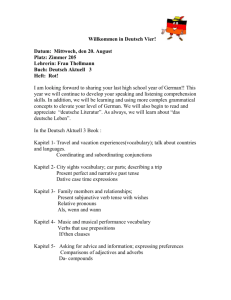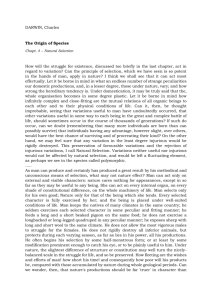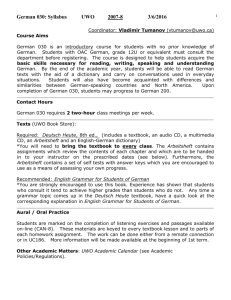THE ORIGIN OF SPECIES
advertisement
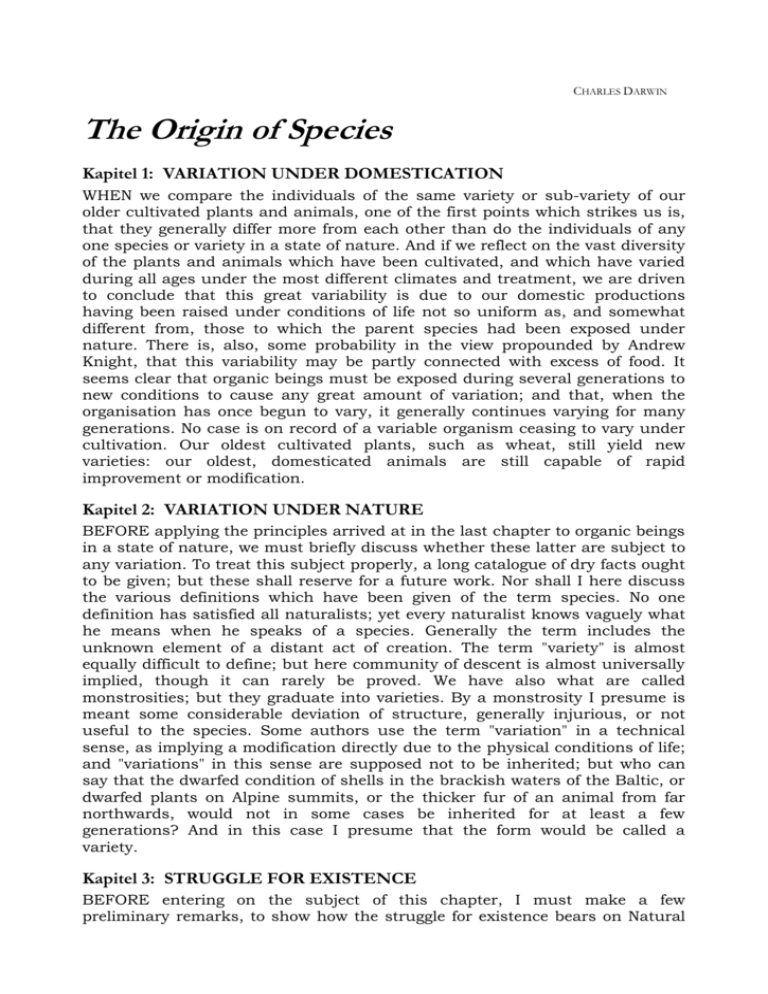
CHARLES DARWIN The Origin of Species Kapitel 1: VARIATION UNDER DOMESTICATION WHEN we compare the individuals of the same variety or sub-variety of our older cultivated plants and animals, one of the first points which strikes us is, that they generally differ more from each other than do the individuals of any one species or variety in a state of nature. And if we reflect on the vast diversity of the plants and animals which have been cultivated, and which have varied during all ages under the most different climates and treatment, we are driven to conclude that this great variability is due to our domestic productions having been raised under conditions of life not so uniform as, and somewhat different from, those to which the parent species had been exposed under nature. There is, also, some probability in the view propounded by Andrew Knight, that this variability may be partly connected with excess of food. It seems clear that organic beings must be exposed during several generations to new conditions to cause any great amount of variation; and that, when the organisation has once begun to vary, it generally continues varying for many generations. No case is on record of a variable organism ceasing to vary under cultivation. Our oldest cultivated plants, such as wheat, still yield new varieties: our oldest, domesticated animals are still capable of rapid improvement or modification. Kapitel 2: VARIATION UNDER NATURE BEFORE applying the principles arrived at in the last chapter to organic beings in a state of nature, we must briefly discuss whether these latter are subject to any variation. To treat this subject properly, a long catalogue of dry facts ought to be given; but these shall reserve for a future work. Nor shall I here discuss the various definitions which have been given of the term species. No one definition has satisfied all naturalists; yet every naturalist knows vaguely what he means when he speaks of a species. Generally the term includes the unknown element of a distant act of creation. The term "variety" is almost equally difficult to define; but here community of descent is almost universally implied, though it can rarely be proved. We have also what are called monstrosities; but they graduate into varieties. By a monstrosity I presume is meant some considerable deviation of structure, generally injurious, or not useful to the species. Some authors use the term "variation" in a technical sense, as implying a modification directly due to the physical conditions of life; and "variations" in this sense are supposed not to be inherited; but who can say that the dwarfed condition of shells in the brackish waters of the Baltic, or dwarfed plants on Alpine summits, or the thicker fur of an animal from far northwards, would not in some cases be inherited for at least a few generations? And in this case I presume that the form would be called a variety. Kapitel 3: STRUGGLE FOR EXISTENCE BEFORE entering on the subject of this chapter, I must make a few preliminary remarks, to show how the struggle for existence bears on Natural Selection. It has been seen in the last chapter that amongst organic beings in a state of nature there is some individual variability: indeed I am not aware that this has ever been disputed. It is immaterial for us whether a multitude of doubtful forms be called species or sub-species or varieties; what rank, for instance, the two or three hundred doubtful forms of British plants are entitled to hold, if the existence of any well-marked varieties be admitted. But the mere existence of individual variability and of some few well-marked varieties, though necessary as the foundation for the work, helps us but little in understanding how species arise in nature. How have all those exquisite adaptations of one part of the organisation to another part, and to the conditions of life, and of one organic being to another being, been perfected? We see these beautiful co-adaptations most plainly in the woodpecker and the mistletoe; and only a little less plainly in the humblest parasite which clings to the hairs of a quadruped or feathers of a bird; in the structure of the beetle which dives through the water; in the plumed seed which is wafted by the gentlest breeze; in short, we see beautiful adaptations everywhere and in every part of the organic world. Kapitel 4: NATURAL SELECTION; OR THE SURVIVAL OF THE FITTEST How will the struggle for existence, briefly discussed in the last chapter, act in regard to variation? Can the principle of selection, which we have seen is so potent in the hands of man, apply under nature? I think we shall see that it can act most efficiently. Let the endless number of slight variations and individual differences occurring in our domestic productions, and, in a lesser degree, in those under nature, be borne in mind; as well as the strength of the hereditary tendency. Under domestication, it may be truly said that the whole organisation becomes in some degree plastic. But the variability, which we almost universally meet with in our domestic productions, is not directly produced, as Hooker and Asa Gray have well remarked, by man; he can neither originate varieties, nor prevent their occurrence; he can preserve and accumulate such as do occur. Unintentionally he exposes organic beings to new and changing conditions of life, and variability ensues; but similar changes of conditions might and do occur under nature. Abb. 4.1 Darwin Let it also be borne in mind how infinitely complex and close-fitting are the mutual relations of all organic beings to each other and to their physical conditions of life; and consequently what infinitely varied diversities of structure might be of use to each being under changing conditions of life. Can it, then, be thought improbable, seeing that variations useful to man have undoubtedly occurred, that other variations useful in some way to each being in the great and complex battle of life, should occur in the course of many successive generations? If such do occur, can we doubt (remembering that many more individuals are born than can possibly survive) that individuals having any advantage, however slight, over others, would have the best chance of surviving and of procreating their kind? On the other hand, we may feel sure that any variation in the least degree injurious would be rigidly destroyed. This preservation of favourable individual differences and variations, and the destruction of those which are injurious, I have called Natural Selection, or the Survival of the Fittest. Variations neither useful nor injurious would not be affected by natural selection, and would be left either a fluctuating element, as perhaps we see in certain polymorphic species, or would ultimately become fixed, owing to the nature of the organism and the nature of the conditions. Kapitel 5: LAWS OF VARIATION I HAVE hitherto sometimes spoken as if the variations- so common and multiform with organic beings under domestication, and in a lesser degree with those under nature- were due to chance. This, of course, is a wholly incorrect expression, but it serves to acknowledge plainly our ignorance of the cause of each particular variation. Some authors believe it to be as much the function of the reproductive system to produce individual differences, or slight deviations of structure, as to make the child like its parents. But the fact of variations and monstrosities occurring much more frequently under domestication than under nature, and the greater variability of species having wider ranges than of those with restricted ranges, lead to the conclusion that variability is generally related to the conditions of life to which each species has been exposed during Abb. 5.1 Darwin finches several successive generations. In the first chapter I attempted to show that changed conditions act in two ways, directly on the whole organisation or on certain parts alone, and indirectly through the reproductive system. In all cases there are two factors, the nature of the organism, which is much the most important of the two, and the nature of the conditions. The direct action of changed conditions leads to definite or indefinite results. In the latter case the organisation seems to become plastic, and we have much fluctuating variability. In the former case the nature of the organism is such that it yields readily, when subjected to certain conditions, and all, or nearly all the individuals become modified in the same way. Kapitel 6: RECAPITULATION AND CONCLUSION AS THIS whole volume is one long argument, it may be convenient to the reader to have the leading facts and inferences briefly recapitulated. That many and serious objections may be advanced against the theory of descent with modification through variation and natural selection, I do not deny. I have endeavoured to give to them their full force. Nothing at first can appear more difficult to believe than that the more complex organs and instincts have been perfected, not by means superior to, though analogous with, human reason, but by the accumulation of innumerable slight variations, each good for the individual possessor. Nevertheless, this difficulty, though appearing to our imagination insuperably great, cannot be considered real if we admit the following propositions, namely, that all parts of the organisation1 and instincts offer BROWN, at least, individual differences- that there is a struggle for existence leading to the preservationi of profitable deviations of structure or instinct- and, lastly, that gradations in the state of perfection of each organ may have existed, each good of its kind. The truth of these propositions cannot, I think, be disputed. BROWN, A.C., A. MCLACHLAN (1994): Ecology of Sandy Shores. Elsevier, Amsterdam: 328 S. BUCHWALD, K. (1991): Nordsee. Ein Lebensraum ohne Zukunft? mit einem Exkurs von W. FELDT und TH. SCHRÖDER. 2., durchges. Aufl.,Verlag Die Werkstatt, Göttingen: 552 S. CHAPMAN, V.J. (1978): Coastal Vegetation. 2. Aufl., Pergamon, Oxford: 292 S. DITTMANN, S. (Hrsg.)(1999): The Wadden Sea Ecosystem. Stability Problems and Mechanisms. Springer, Berlin: 307 S. ELLENBERG, H. (1996): Vegetation Mitteleuropas mit den Alpen in ökologischer, dynamischer und historischer Sicht. 5., stark veränd. und verbess. Aufl., Ulmer, Stuttgart: 1095 S. HEYDEMANN, B., U. IRMLER, & E. LIPKOW (Hrsg.)(1999): Küstendünen and der Nordsee. Faunistisch-ökologische Arbeitsgemeinschaft, Supplement 26 der Faunistisch-ökologischen Mitteilungen, Kiel: 114 S. LEWIS, J.R. (1961): The littoral zone on rocky shores – a biological or physical entity? Oikos, Fasc. 11, 12, 280301 LOBBAN, C.S. & P.J. HARRISON (1994): Seaweed ecology and physiology. Cambridge University Press, Cambridge: 366 S. LÜNING, K. (1985): Meeresbotanik. Verbreitung, Ökophysiologie und Nutzung der marinen Algen. Thieme, Stuttgart: 375 S. OBERDORFER, E. (1994): Pflanzensoziologische Exkursionsflora. unter Mitarb. von TH. MÜLLER, mit Beitr. von D. KORNECK et al. 7., überarb. und erg. Aufl.,Ulmer, Stuttgart: 1050 S. POTTS, R. (1995): Die Pflanzengesellschaften Deutschlands. 2. überarb. und stark erw. Aufl., Ulmer, Stuttgart: 622 S. i xyz hat das selbe gesagt 1 blablabla
